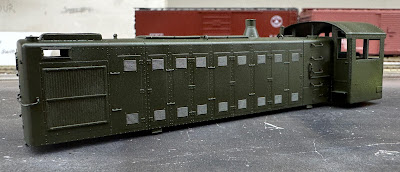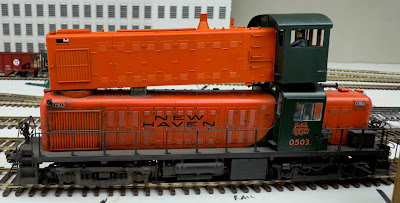During the tail end of recovering from Covid I decided an easy thing to work on would be some painting. Getting out the airbrush is one of those things that seems much more complicated than it really is. Especially since I've set things up to be as quick as possible, both getting started and getting cleaned up. I've done a few posts on the DEY-3 project before:
Part I: Installing DCC - Part II: Details - Part III: More Details
Some time ago I painted body and cab for what will be 0967, then installed the windows and it's ready for next steps. This was an easy job since it's all Pullman Green. I used Stynylrez gray primer and Badger New Haven Pullman Green.
Incidentally, 0967 also ran on the Valley Line for a while, and Chris has done an extensive series of how he modeled this locomotive. His progress is part of what got me looking at my models again. There's little point in me describing the same steps that he took for his excellent model. Here are his posts:
- Part 0: Research
- Part I
- Part II: Decoder Install and Test
- Part III: Bodywork
- Part IV: Adding Details
- Part V: More Details
- Part VI: Test Run
- Part VII: Low Profile Cab
- Part VIII: Painting
- Part IX: Lettering
- Part X: Weathering
Now that Chris has so thoughtfully asked (assigned) me to be editor of Speed Witch, I expect a draft of this article soon...
The second unit, 0994, was delivered in Hunter Green and Warm Orange. I had started this some time ago, but wasn't quite getting an orange that I liked. The Badger New Haven Warm Orange looks right, but over the gray primer it looked dingy. So I tried it over Stynylrez white primer, and then it was too bright.
Then I found out Stynylrez has an orange primer (they also have a dark green). That's what I used this time, and the Badger looked good over it, but still not quite the correct orange. Orange paints are fairly transparent, and it takes several coats to get to the actual color that it appears with a full coat. I decided to take advantage of this effect and try what is often called a "filter." This is using a thin coat of paint over the existing color in order to alter it. In this case, Vallejo Air orange had a bit more red (I think) in it. It doesn't look right by itself, but I thought that it would shift the Badger orange just enough. After a couple of thin coats of the Vallejo orange, I compared it to the NH Color Guide paint chip:
It's not a perfect match, but I'm very happy with how close it is. It's also repeatable, and that's what I did for the back of the cab - Stynylrez orange primer, Badger NH Warm Orange, and Vallejo Air orange in that order. The green is Stynylrex green primer with Badger NH Hunter Green. Here it is next to the Pullman Green 0967. The back of the cab looks like it has a bit more red in this photo, but that appears to be a combination of the lighting, angle, and how the camera picks it up since it doesn't look that way in person.








.jpeg)
.jpeg)


%200500%20Builder's%20Photo.jpg)
